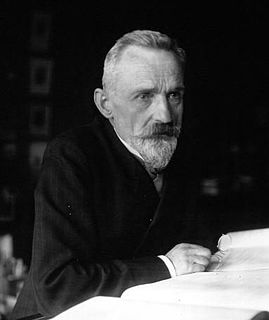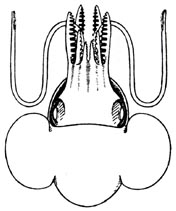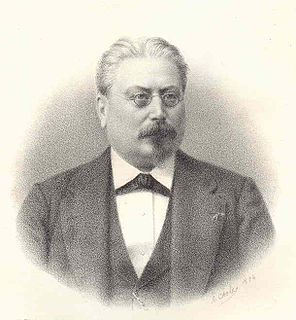
Henri Milne-Edwards was an eminent French zoologist.

Alphonse Milne-Edwards was a French mammalogist, ornithologist, and carcinologist. He was English in origin, the son of Henri Milne-Edwards and grandson of Bryan Edwards, a Jamaican planter who settled at Bruges.

Jean-Frédéric Émile Oustalet was a French zoologist.

Léon Louis Vaillant was a French zoologist. He is most famous for his work in the areas of herpetology, malacology, and ichthyology.

Pierre-Hippolyte Lucas was a French entomologist.

Eugène Louis Bouvier was a French entomologist and carcinologist. Bouvier was a professor at the Muséum national d'histoire naturelle.

Nectoteuthis pourtalesi is a bathybenthic species of bobtail squid native to the tropical western Atlantic Ocean, specifically Florida and the Antilles.

Henri Gadeau de Kerville was a French zoologist, entomologist, botanist and archeologist best known for his photographs of these subjects and especially for his work "Les Insectes phosphorescents: notes complémentaires et bibliographie générale : avec quatre planches chromolithographiées", Rouen, L. Deshays, 1881.

Henri Filhol was a French medical doctor, malacologist and naturalist born in Toulouse. He was the son of Édouard Filhol (1814-1883), curator of the Muséum de Toulouse.

Léopold de Folin was an author, oceanographer, malacologist and early founder (1871) of the collections which were to become the Musée de la mer in Biarritz, France

Jules René Bourguignat was a French malacologist, a scientist who studied mollusks. He served as secretary-general of the Société malacologique de France. He traveled widely, visiting, for example, Lake Tanganyika and North Africa. He reportedly defined 112 new genera and around 2540 new species of mollusks.

Trophonopsis droueti is a species of sea snail, a marine gastropod mollusk in the family Muricidae, the murex snails or rock snails.

Cerithium lividulum is a species of sea snail, a marine gastropod mollusk in the family Cerithiidae.
François Mocquard was a French herpetologist born in Leffond, Haute-Saône.

Jean Octave Edmond Perrier was a French zoologist born in Tulle. He is known for his studies of invertebrates. He was the brother of zoologist Rémy Perrier (1861–1936).

Jean Baptiste François René Koehler was a French zoologist best known for his research of echinoderms.

Adrien Frédéric Jules Dollfus was a French carcinologist known for his work with terrestrial isopods, including crustaceans and trilobites.
Albert Jean Baptiste Marie Vayssière was a French scientist, a biologist, specifically a malacologist and entomologist, i.e. someone who studies mollusks, and insects. Within the Mollusca, Vayssière specialized in sea slugs and bubble snails, i.e. marine opisthobranch gastropods. He made significant contributions towards a better understanding of the general biology, phylogenetic relationships, biogeography and ecological distribution of the group.

Napoléon Doumet-Adanson (22 October 1834, Guéret – 31 May 1897 Château de Balaine was a French naturalist. He was a botanist specialising in the flora of Tunisia. He was a founder member of the Société d'horticulture et de botanique de l'Hérault. Doumet was also interested in entomology. He was a Member of the Institut de France.

Glyphus is a genus of shrimp from the family Pasiphaeidae, first described by Henri Filhol in 1884. The type species is Glyphus marsupialis, by monotypy.





















